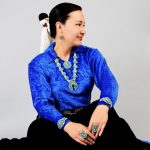October 4, 2018

Sonsee’rae Sells earned her master’s in Clinical Mental Health Counseling-Transpersonal Art Therapy from Naropa University in May 2018 and works as a clinical counselor at Family Crisis Center in Farmington, New Mexico. She values her AATA membership for the liability insurance it offered her as a student and for access to the Journal and to networking opportunities. Sells holds a BA from the Institute of American Indian Arts in Santa Fe, NM. Before “entering the mindset of an art therapist,” she recalls experiencing “art as a way to send a message involving social justice.” Now she can also experience art as a way to listen, learn, and grow.
Of her experience in the arts as a Navajo woman, Sells shares:
Yá’át’ééh. Sonsee’rae Sells éí da shijiní. Totah, NM déé naashá. Táá Diné dóó Biligaana nishłį́. Shi éí biligaana nishłį́. Hoogan łaní báshishchíín. Aadoo Biligaana éí da shícheii dóó Todichiinii éí da shinalí. Ákót’éego diné asdzáán nishłį́. Greetings. They call me Sonsee’rae Sells. I come from Farmington, New Mexico. I am half Navajo and half White. I am White People clan born for Many Hogan clan. My maternal grandfather was White people clan and paternal grandfather was Bitter Water clan. In this way, I am a Navajo woman. (Navajo is also Diné, which means the people.)
Historically art was taken away from my ancestors as a way of control. Yet Indigenous creations are valued and sold based on identity. Growing up, art was a safe way to escape a world where I did not feel accepted. Then I learned in college that to be an artist was to sell myself as an American Indian by making beadwork or weaving rugs. Art was no longer a safe escape, yet it became my way to understand what was important about creating. I learned through art therapy that there are other options such as healing through creativity.

“Choosing Battles” by Sonsee'rae Sells. Cardboard and Soda Tabs. May 2018.
Artist’s statement: “Art is a way for me to disconnect from reality momentarily and reconnect to myself. I create art to gain insight about experiences, such as trauma, that are challenging to articulate. The type of skills to make this armor promote an attention to detail, patience, and fine motor abilities. I enjoy tedious sequences like beading and repetition. My armor is a symbolic representation of my experience as a training art therapist.
Practicing Western therapeutic perspectives that contradict my Indigenous values felt like I was challenging what was being taught. Once social justice counseling was introduced at my internship site, I fell in love with being an advocate or social justice warrior. The fiery anger that manifests inside me from unjust historical events makes communicating conflict difficult. I want to continue to practice choosing my battles and strengthen my ability to cope with unfair situations. I also want to incorporate action for change as an art activist. This armor is a reminder to stay true to my values as an American Indian, as a social justice advocate, and as a therapist."
